Financial and Economic Literacy for Managers - University Report
VerifiedAdded on 2020/04/21
|19
|3975
|82
Report
AI Summary
This report delves into financial and economic literacy for managers, providing an in-depth analysis of key concepts. It begins by examining the Structure, Conduct, and Performance (SCP) paradigm in the context of Amazon, exploring its market structure, competitive advantages, and international revenue growth. The report then analyzes demand and supply dynamics, elasticity, and inflation using the example of potato price index movements in the UK. Furthermore, it discusses UK government competition, fiscal, and supply-side policies, highlighting their impact on the economy. The report concludes by emphasizing the importance of financial statements for managerial decision-making, including planning, control, and preventing financial misappropriation. Overall, this report provides a comprehensive overview of financial and economic literacy, equipping managers with essential knowledge for effective decision-making.
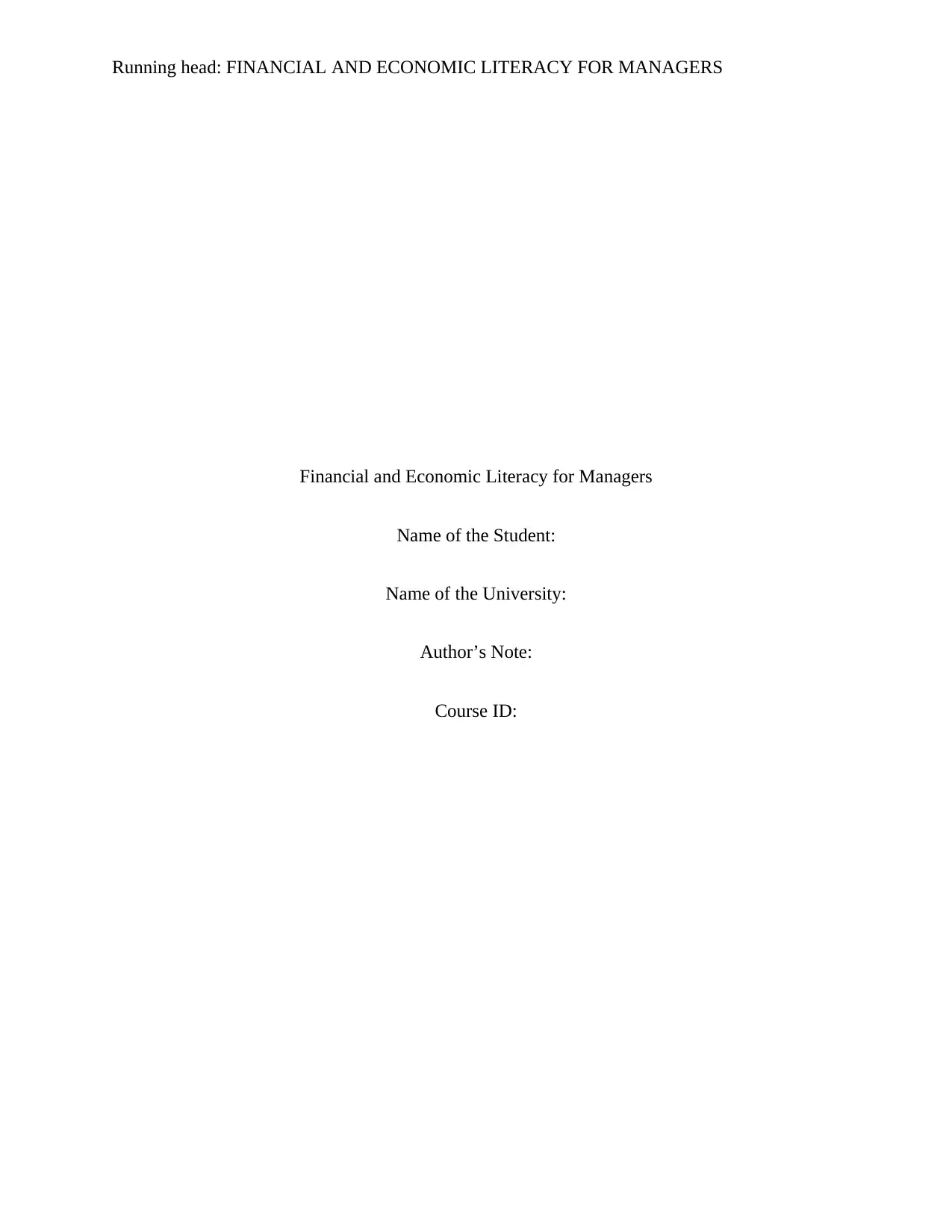
Running head: FINANCIAL AND ECONOMIC LITERACY FOR MANAGERS
Financial and Economic Literacy for Managers
Name of the Student:
Name of the University:
Author’s Note:
Course ID:
Financial and Economic Literacy for Managers
Name of the Student:
Name of the University:
Author’s Note:
Course ID:
Paraphrase This Document
Need a fresh take? Get an instant paraphrase of this document with our AI Paraphraser
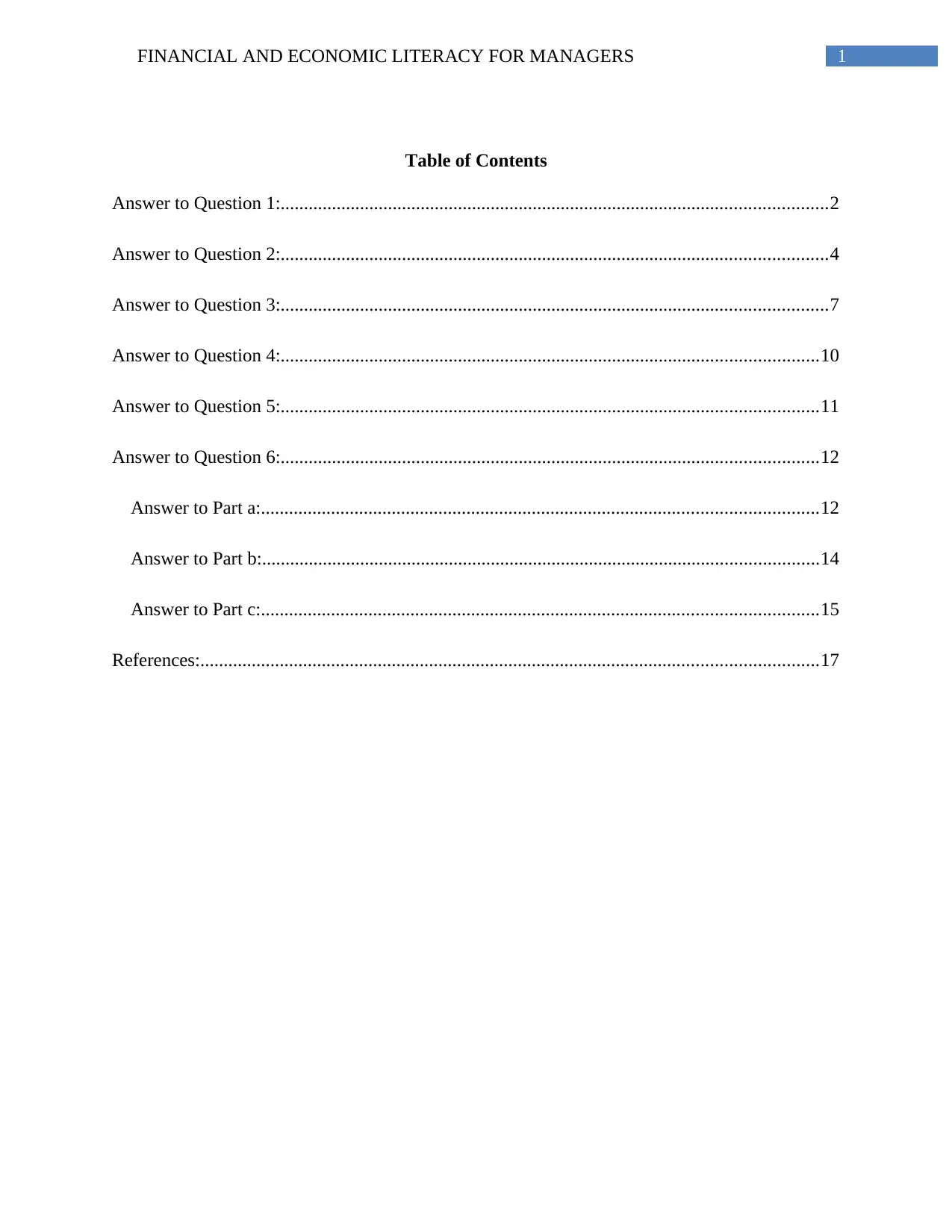
1FINANCIAL AND ECONOMIC LITERACY FOR MANAGERS
Table of Contents
Answer to Question 1:.....................................................................................................................2
Answer to Question 2:.....................................................................................................................4
Answer to Question 3:.....................................................................................................................7
Answer to Question 4:...................................................................................................................10
Answer to Question 5:...................................................................................................................11
Answer to Question 6:...................................................................................................................12
Answer to Part a:.......................................................................................................................12
Answer to Part b:.......................................................................................................................14
Answer to Part c:.......................................................................................................................15
References:....................................................................................................................................17
Table of Contents
Answer to Question 1:.....................................................................................................................2
Answer to Question 2:.....................................................................................................................4
Answer to Question 3:.....................................................................................................................7
Answer to Question 4:...................................................................................................................10
Answer to Question 5:...................................................................................................................11
Answer to Question 6:...................................................................................................................12
Answer to Part a:.......................................................................................................................12
Answer to Part b:.......................................................................................................................14
Answer to Part c:.......................................................................................................................15
References:....................................................................................................................................17
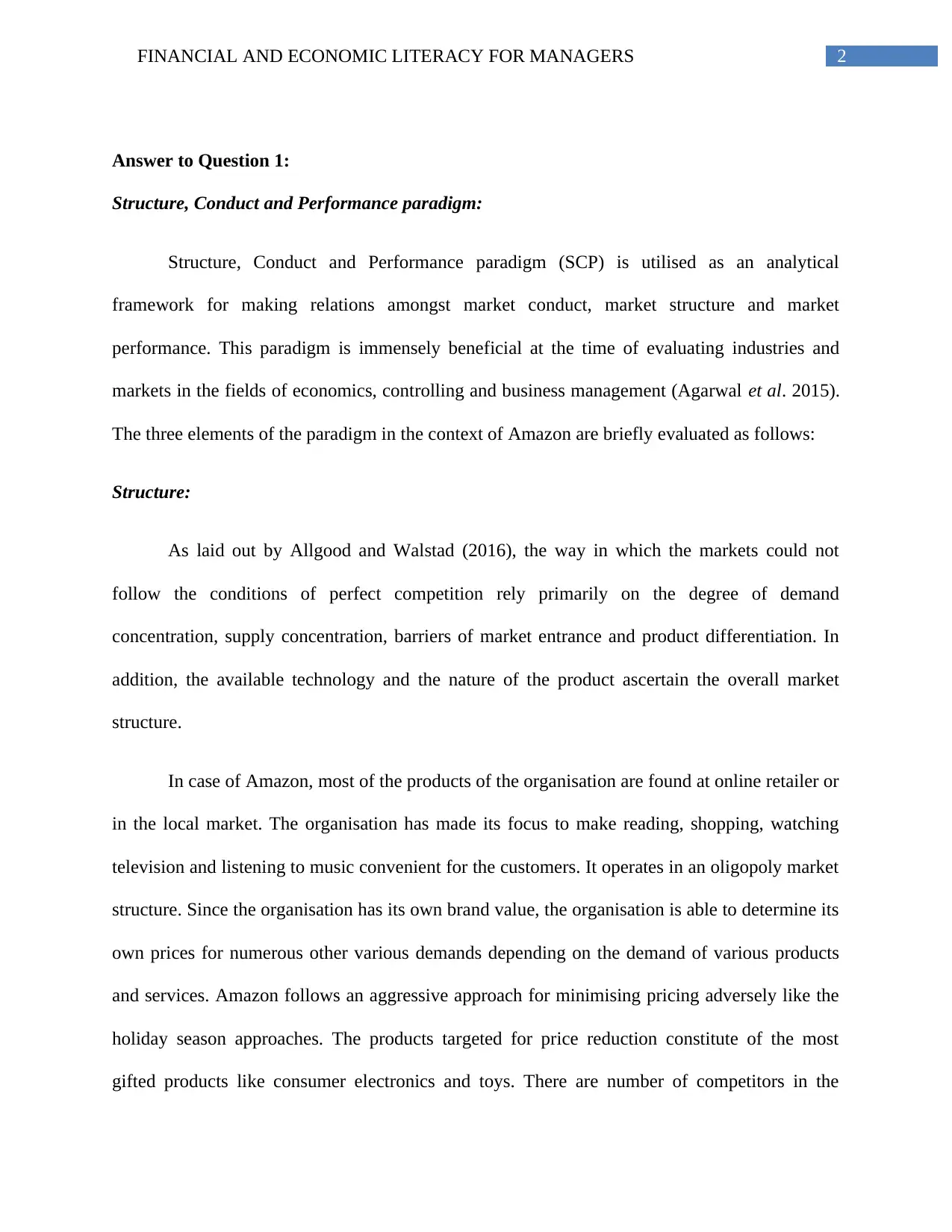
2FINANCIAL AND ECONOMIC LITERACY FOR MANAGERS
Answer to Question 1:
Structure, Conduct and Performance paradigm:
Structure, Conduct and Performance paradigm (SCP) is utilised as an analytical
framework for making relations amongst market conduct, market structure and market
performance. This paradigm is immensely beneficial at the time of evaluating industries and
markets in the fields of economics, controlling and business management (Agarwal et al. 2015).
The three elements of the paradigm in the context of Amazon are briefly evaluated as follows:
Structure:
As laid out by Allgood and Walstad (2016), the way in which the markets could not
follow the conditions of perfect competition rely primarily on the degree of demand
concentration, supply concentration, barriers of market entrance and product differentiation. In
addition, the available technology and the nature of the product ascertain the overall market
structure.
In case of Amazon, most of the products of the organisation are found at online retailer or
in the local market. The organisation has made its focus to make reading, shopping, watching
television and listening to music convenient for the customers. It operates in an oligopoly market
structure. Since the organisation has its own brand value, the organisation is able to determine its
own prices for numerous other various demands depending on the demand of various products
and services. Amazon follows an aggressive approach for minimising pricing adversely like the
holiday season approaches. The products targeted for price reduction constitute of the most
gifted products like consumer electronics and toys. There are number of competitors in the
Answer to Question 1:
Structure, Conduct and Performance paradigm:
Structure, Conduct and Performance paradigm (SCP) is utilised as an analytical
framework for making relations amongst market conduct, market structure and market
performance. This paradigm is immensely beneficial at the time of evaluating industries and
markets in the fields of economics, controlling and business management (Agarwal et al. 2015).
The three elements of the paradigm in the context of Amazon are briefly evaluated as follows:
Structure:
As laid out by Allgood and Walstad (2016), the way in which the markets could not
follow the conditions of perfect competition rely primarily on the degree of demand
concentration, supply concentration, barriers of market entrance and product differentiation. In
addition, the available technology and the nature of the product ascertain the overall market
structure.
In case of Amazon, most of the products of the organisation are found at online retailer or
in the local market. The organisation has made its focus to make reading, shopping, watching
television and listening to music convenient for the customers. It operates in an oligopoly market
structure. Since the organisation has its own brand value, the organisation is able to determine its
own prices for numerous other various demands depending on the demand of various products
and services. Amazon follows an aggressive approach for minimising pricing adversely like the
holiday season approaches. The products targeted for price reduction constitute of the most
gifted products like consumer electronics and toys. There are number of competitors in the
⊘ This is a preview!⊘
Do you want full access?
Subscribe today to unlock all pages.

Trusted by 1+ million students worldwide
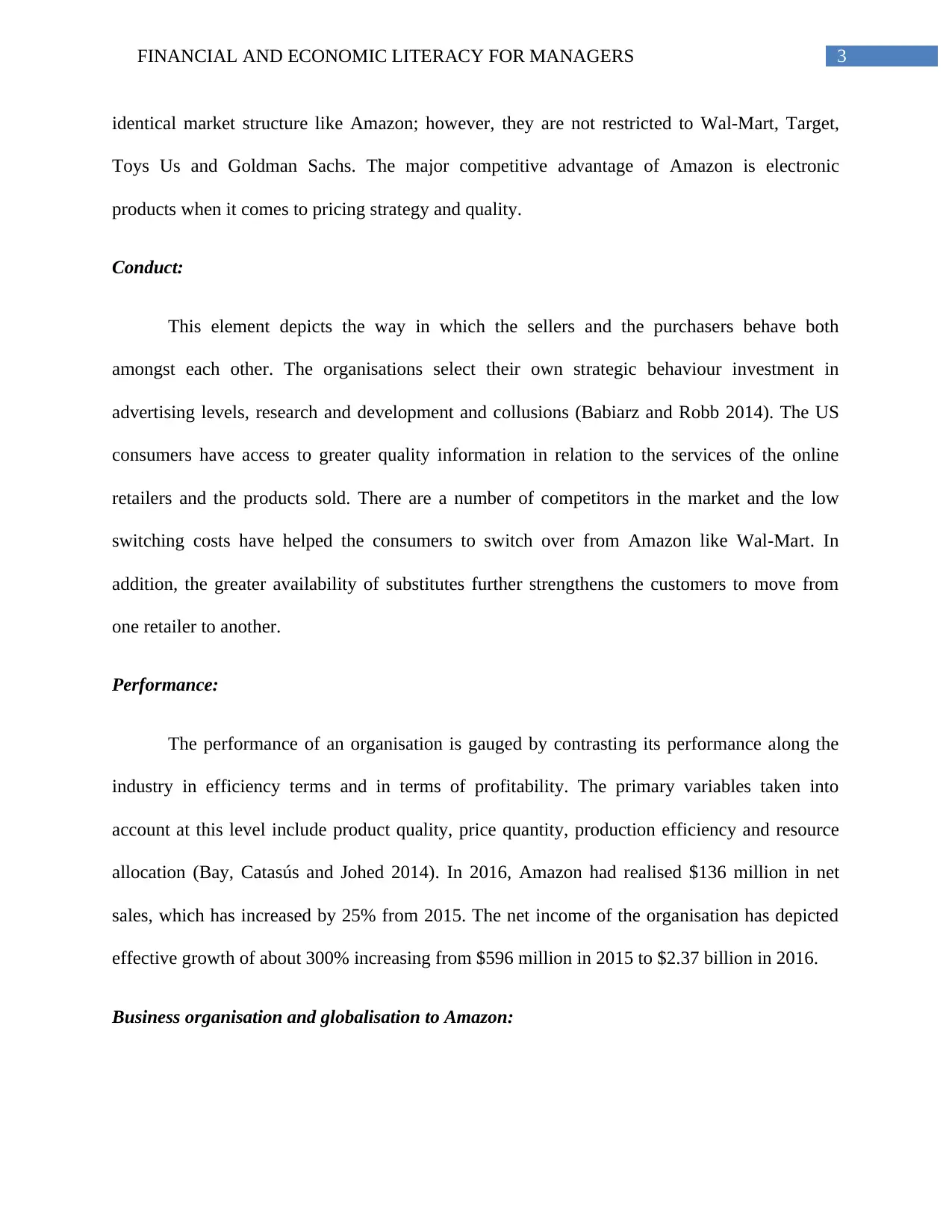
3FINANCIAL AND ECONOMIC LITERACY FOR MANAGERS
identical market structure like Amazon; however, they are not restricted to Wal-Mart, Target,
Toys Us and Goldman Sachs. The major competitive advantage of Amazon is electronic
products when it comes to pricing strategy and quality.
Conduct:
This element depicts the way in which the sellers and the purchasers behave both
amongst each other. The organisations select their own strategic behaviour investment in
advertising levels, research and development and collusions (Babiarz and Robb 2014). The US
consumers have access to greater quality information in relation to the services of the online
retailers and the products sold. There are a number of competitors in the market and the low
switching costs have helped the consumers to switch over from Amazon like Wal-Mart. In
addition, the greater availability of substitutes further strengthens the customers to move from
one retailer to another.
Performance:
The performance of an organisation is gauged by contrasting its performance along the
industry in efficiency terms and in terms of profitability. The primary variables taken into
account at this level include product quality, price quantity, production efficiency and resource
allocation (Bay, Catasús and Johed 2014). In 2016, Amazon had realised $136 million in net
sales, which has increased by 25% from 2015. The net income of the organisation has depicted
effective growth of about 300% increasing from $596 million in 2015 to $2.37 billion in 2016.
Business organisation and globalisation to Amazon:
identical market structure like Amazon; however, they are not restricted to Wal-Mart, Target,
Toys Us and Goldman Sachs. The major competitive advantage of Amazon is electronic
products when it comes to pricing strategy and quality.
Conduct:
This element depicts the way in which the sellers and the purchasers behave both
amongst each other. The organisations select their own strategic behaviour investment in
advertising levels, research and development and collusions (Babiarz and Robb 2014). The US
consumers have access to greater quality information in relation to the services of the online
retailers and the products sold. There are a number of competitors in the market and the low
switching costs have helped the consumers to switch over from Amazon like Wal-Mart. In
addition, the greater availability of substitutes further strengthens the customers to move from
one retailer to another.
Performance:
The performance of an organisation is gauged by contrasting its performance along the
industry in efficiency terms and in terms of profitability. The primary variables taken into
account at this level include product quality, price quantity, production efficiency and resource
allocation (Bay, Catasús and Johed 2014). In 2016, Amazon had realised $136 million in net
sales, which has increased by 25% from 2015. The net income of the organisation has depicted
effective growth of about 300% increasing from $596 million in 2015 to $2.37 billion in 2016.
Business organisation and globalisation to Amazon:
Paraphrase This Document
Need a fresh take? Get an instant paraphrase of this document with our AI Paraphraser
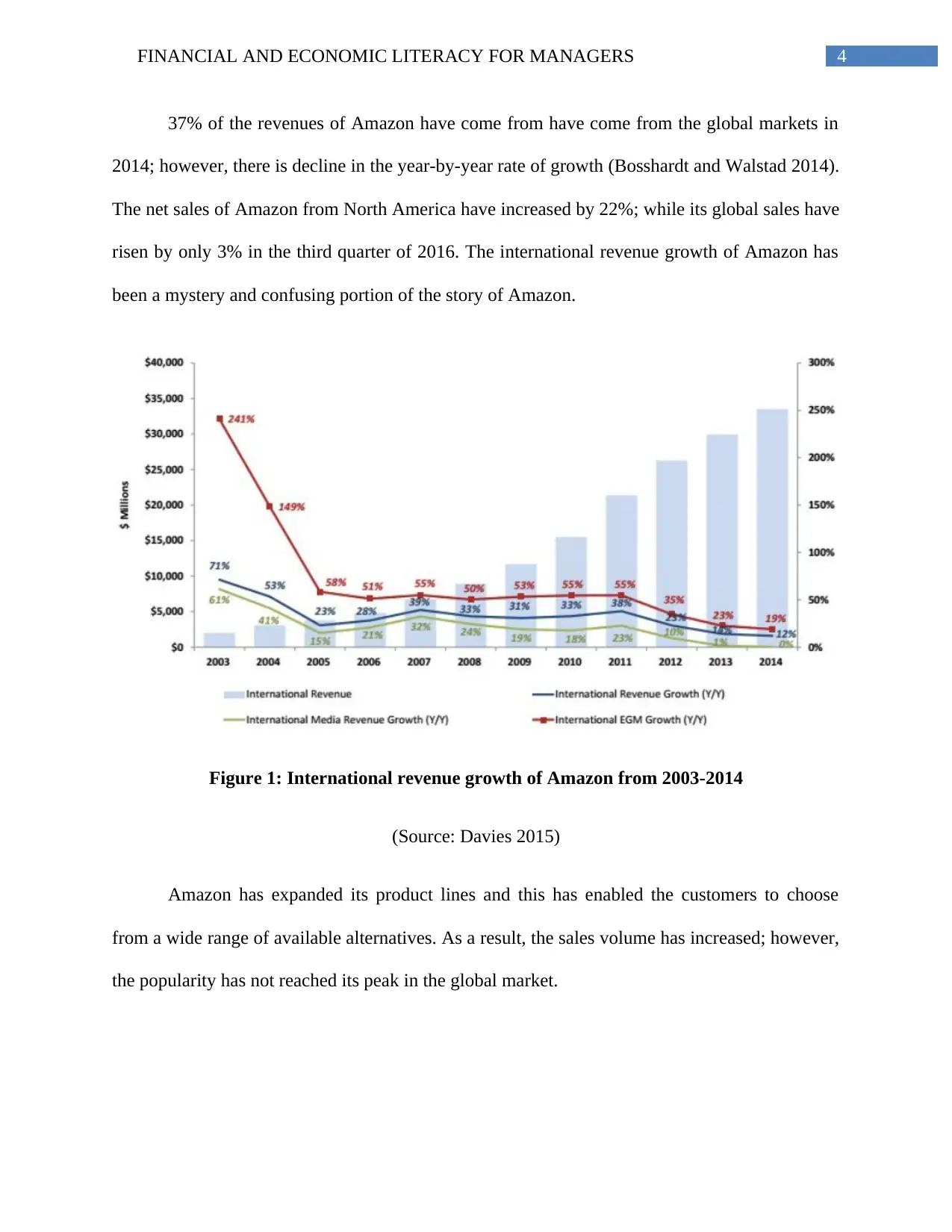
4FINANCIAL AND ECONOMIC LITERACY FOR MANAGERS
37% of the revenues of Amazon have come from have come from the global markets in
2014; however, there is decline in the year-by-year rate of growth (Bosshardt and Walstad 2014).
The net sales of Amazon from North America have increased by 22%; while its global sales have
risen by only 3% in the third quarter of 2016. The international revenue growth of Amazon has
been a mystery and confusing portion of the story of Amazon.
Figure 1: International revenue growth of Amazon from 2003-2014
(Source: Davies 2015)
Amazon has expanded its product lines and this has enabled the customers to choose
from a wide range of available alternatives. As a result, the sales volume has increased; however,
the popularity has not reached its peak in the global market.
37% of the revenues of Amazon have come from have come from the global markets in
2014; however, there is decline in the year-by-year rate of growth (Bosshardt and Walstad 2014).
The net sales of Amazon from North America have increased by 22%; while its global sales have
risen by only 3% in the third quarter of 2016. The international revenue growth of Amazon has
been a mystery and confusing portion of the story of Amazon.
Figure 1: International revenue growth of Amazon from 2003-2014
(Source: Davies 2015)
Amazon has expanded its product lines and this has enabled the customers to choose
from a wide range of available alternatives. As a result, the sales volume has increased; however,
the popularity has not reached its peak in the global market.
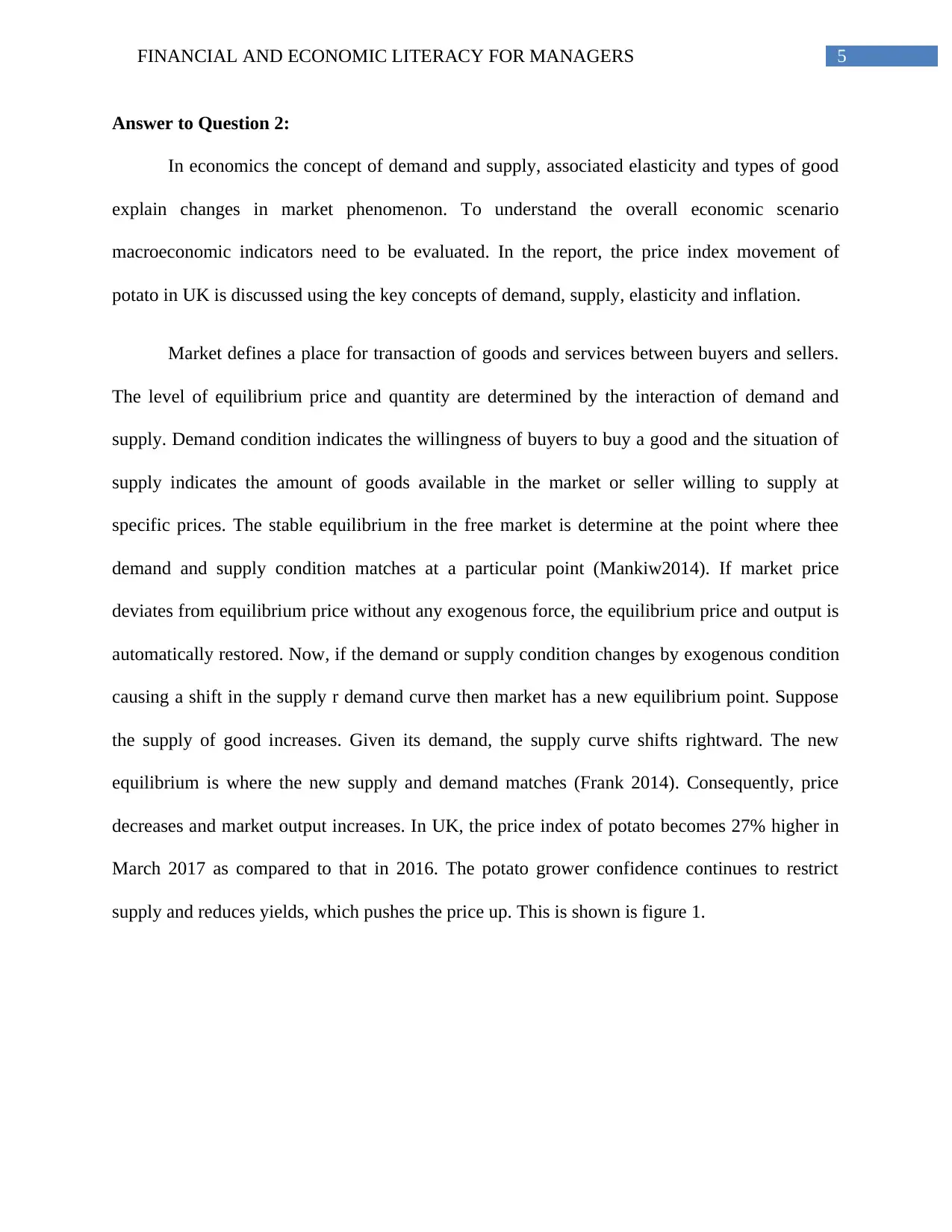
5FINANCIAL AND ECONOMIC LITERACY FOR MANAGERS
Answer to Question 2:
In economics the concept of demand and supply, associated elasticity and types of good
explain changes in market phenomenon. To understand the overall economic scenario
macroeconomic indicators need to be evaluated. In the report, the price index movement of
potato in UK is discussed using the key concepts of demand, supply, elasticity and inflation.
Market defines a place for transaction of goods and services between buyers and sellers.
The level of equilibrium price and quantity are determined by the interaction of demand and
supply. Demand condition indicates the willingness of buyers to buy a good and the situation of
supply indicates the amount of goods available in the market or seller willing to supply at
specific prices. The stable equilibrium in the free market is determine at the point where thee
demand and supply condition matches at a particular point (Mankiw2014). If market price
deviates from equilibrium price without any exogenous force, the equilibrium price and output is
automatically restored. Now, if the demand or supply condition changes by exogenous condition
causing a shift in the supply r demand curve then market has a new equilibrium point. Suppose
the supply of good increases. Given its demand, the supply curve shifts rightward. The new
equilibrium is where the new supply and demand matches (Frank 2014). Consequently, price
decreases and market output increases. In UK, the price index of potato becomes 27% higher in
March 2017 as compared to that in 2016. The potato grower confidence continues to restrict
supply and reduces yields, which pushes the price up. This is shown is figure 1.
Answer to Question 2:
In economics the concept of demand and supply, associated elasticity and types of good
explain changes in market phenomenon. To understand the overall economic scenario
macroeconomic indicators need to be evaluated. In the report, the price index movement of
potato in UK is discussed using the key concepts of demand, supply, elasticity and inflation.
Market defines a place for transaction of goods and services between buyers and sellers.
The level of equilibrium price and quantity are determined by the interaction of demand and
supply. Demand condition indicates the willingness of buyers to buy a good and the situation of
supply indicates the amount of goods available in the market or seller willing to supply at
specific prices. The stable equilibrium in the free market is determine at the point where thee
demand and supply condition matches at a particular point (Mankiw2014). If market price
deviates from equilibrium price without any exogenous force, the equilibrium price and output is
automatically restored. Now, if the demand or supply condition changes by exogenous condition
causing a shift in the supply r demand curve then market has a new equilibrium point. Suppose
the supply of good increases. Given its demand, the supply curve shifts rightward. The new
equilibrium is where the new supply and demand matches (Frank 2014). Consequently, price
decreases and market output increases. In UK, the price index of potato becomes 27% higher in
March 2017 as compared to that in 2016. The potato grower confidence continues to restrict
supply and reduces yields, which pushes the price up. This is shown is figure 1.
⊘ This is a preview!⊘
Do you want full access?
Subscribe today to unlock all pages.

Trusted by 1+ million students worldwide
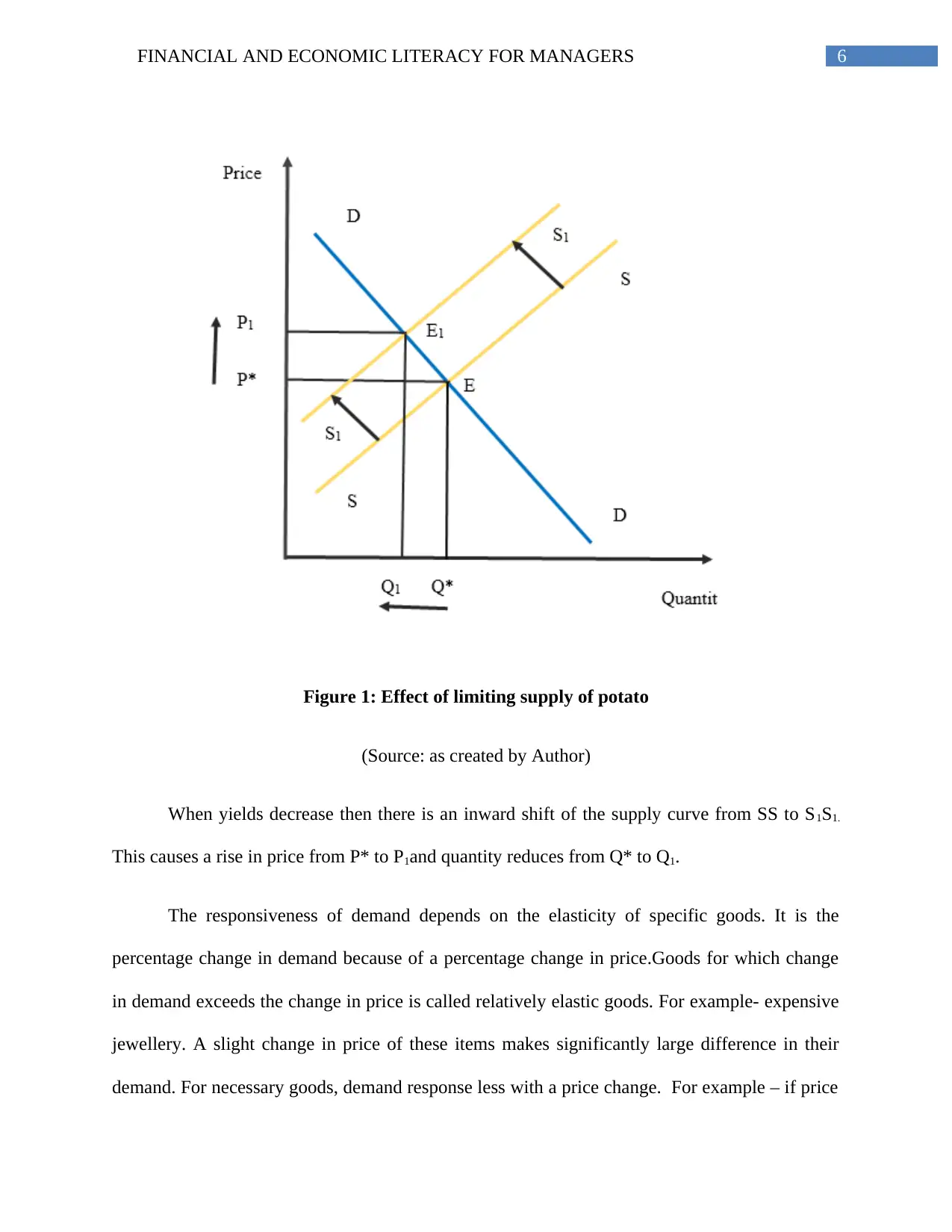
6FINANCIAL AND ECONOMIC LITERACY FOR MANAGERS
Figure 1: Effect of limiting supply of potato
(Source: as created by Author)
When yields decrease then there is an inward shift of the supply curve from SS to S1S1.
This causes a rise in price from P* to P1and quantity reduces from Q* to Q1.
The responsiveness of demand depends on the elasticity of specific goods. It is the
percentage change in demand because of a percentage change in price.Goods for which change
in demand exceeds the change in price is called relatively elastic goods. For example- expensive
jewellery. A slight change in price of these items makes significantly large difference in their
demand. For necessary goods, demand response less with a price change. For example – if price
Figure 1: Effect of limiting supply of potato
(Source: as created by Author)
When yields decrease then there is an inward shift of the supply curve from SS to S1S1.
This causes a rise in price from P* to P1and quantity reduces from Q* to Q1.
The responsiveness of demand depends on the elasticity of specific goods. It is the
percentage change in demand because of a percentage change in price.Goods for which change
in demand exceeds the change in price is called relatively elastic goods. For example- expensive
jewellery. A slight change in price of these items makes significantly large difference in their
demand. For necessary goods, demand response less with a price change. For example – if price
Paraphrase This Document
Need a fresh take? Get an instant paraphrase of this document with our AI Paraphraser
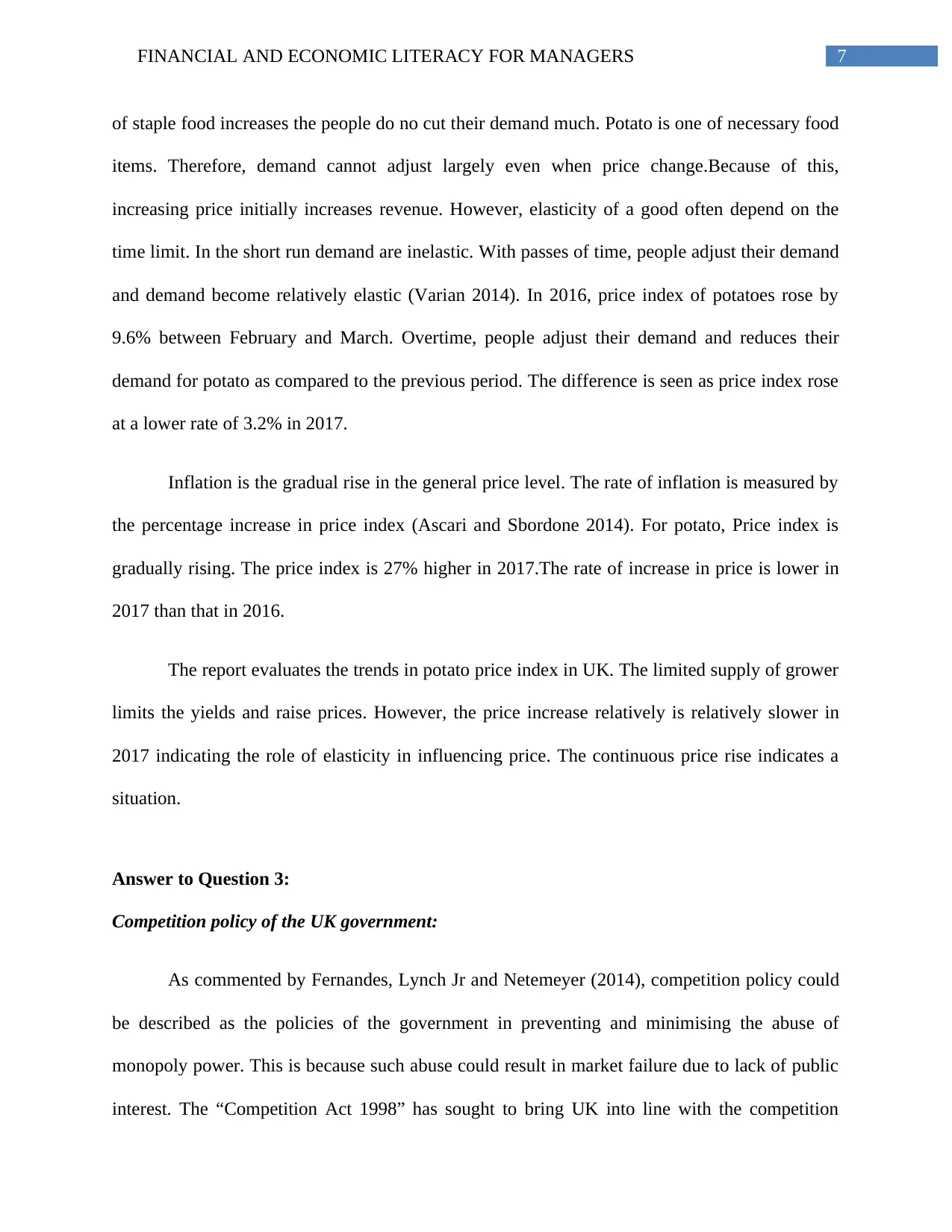
7FINANCIAL AND ECONOMIC LITERACY FOR MANAGERS
of staple food increases the people do no cut their demand much. Potato is one of necessary food
items. Therefore, demand cannot adjust largely even when price change.Because of this,
increasing price initially increases revenue. However, elasticity of a good often depend on the
time limit. In the short run demand are inelastic. With passes of time, people adjust their demand
and demand become relatively elastic (Varian 2014). In 2016, price index of potatoes rose by
9.6% between February and March. Overtime, people adjust their demand and reduces their
demand for potato as compared to the previous period. The difference is seen as price index rose
at a lower rate of 3.2% in 2017.
Inflation is the gradual rise in the general price level. The rate of inflation is measured by
the percentage increase in price index (Ascari and Sbordone 2014). For potato, Price index is
gradually rising. The price index is 27% higher in 2017.The rate of increase in price is lower in
2017 than that in 2016.
The report evaluates the trends in potato price index in UK. The limited supply of grower
limits the yields and raise prices. However, the price increase relatively is relatively slower in
2017 indicating the role of elasticity in influencing price. The continuous price rise indicates a
situation.
Answer to Question 3:
Competition policy of the UK government:
As commented by Fernandes, Lynch Jr and Netemeyer (2014), competition policy could
be described as the policies of the government in preventing and minimising the abuse of
monopoly power. This is because such abuse could result in market failure due to lack of public
interest. The “Competition Act 1998” has sought to bring UK into line with the competition
of staple food increases the people do no cut their demand much. Potato is one of necessary food
items. Therefore, demand cannot adjust largely even when price change.Because of this,
increasing price initially increases revenue. However, elasticity of a good often depend on the
time limit. In the short run demand are inelastic. With passes of time, people adjust their demand
and demand become relatively elastic (Varian 2014). In 2016, price index of potatoes rose by
9.6% between February and March. Overtime, people adjust their demand and reduces their
demand for potato as compared to the previous period. The difference is seen as price index rose
at a lower rate of 3.2% in 2017.
Inflation is the gradual rise in the general price level. The rate of inflation is measured by
the percentage increase in price index (Ascari and Sbordone 2014). For potato, Price index is
gradually rising. The price index is 27% higher in 2017.The rate of increase in price is lower in
2017 than that in 2016.
The report evaluates the trends in potato price index in UK. The limited supply of grower
limits the yields and raise prices. However, the price increase relatively is relatively slower in
2017 indicating the role of elasticity in influencing price. The continuous price rise indicates a
situation.
Answer to Question 3:
Competition policy of the UK government:
As commented by Fernandes, Lynch Jr and Netemeyer (2014), competition policy could
be described as the policies of the government in preventing and minimising the abuse of
monopoly power. This is because such abuse could result in market failure due to lack of public
interest. The “Competition Act 1998” has sought to bring UK into line with the competition
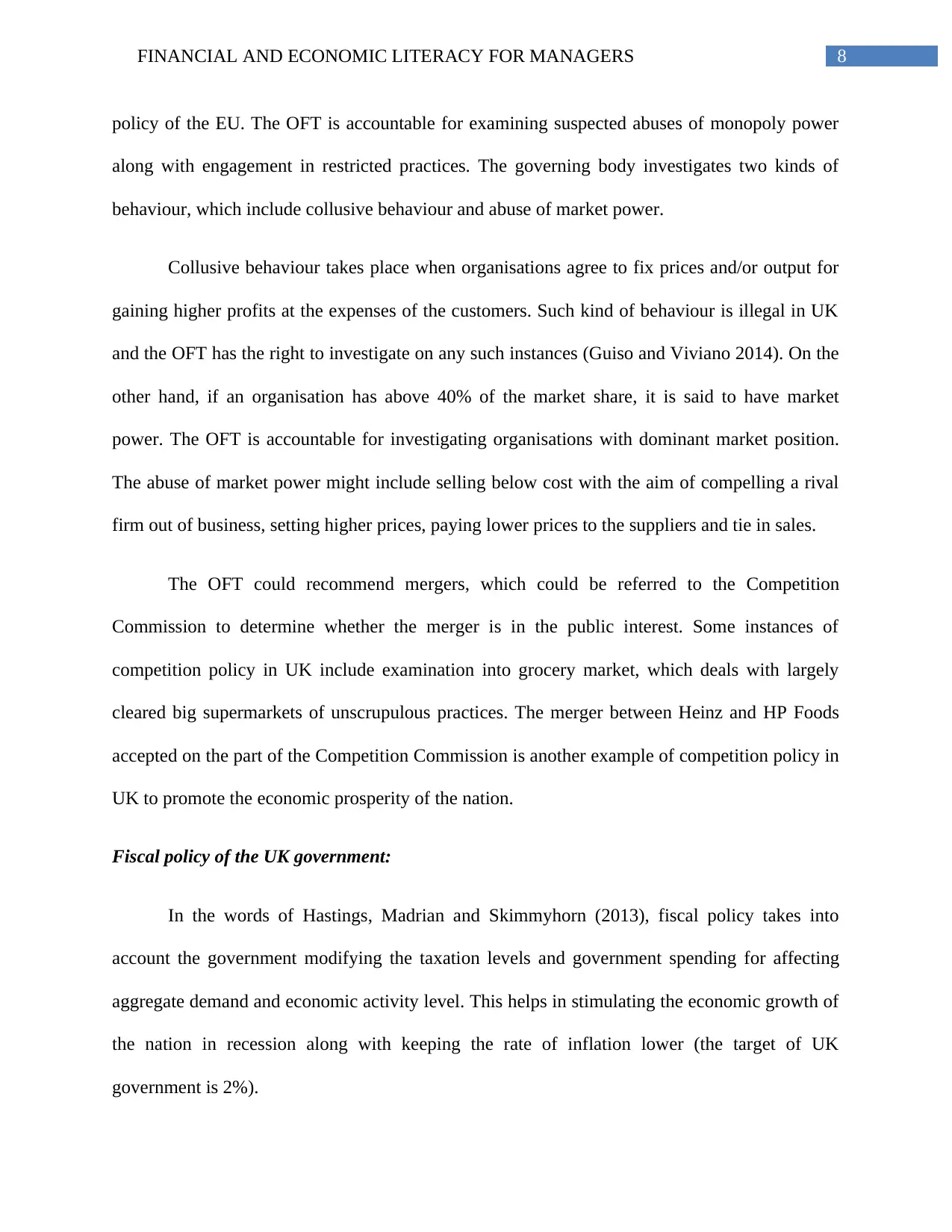
8FINANCIAL AND ECONOMIC LITERACY FOR MANAGERS
policy of the EU. The OFT is accountable for examining suspected abuses of monopoly power
along with engagement in restricted practices. The governing body investigates two kinds of
behaviour, which include collusive behaviour and abuse of market power.
Collusive behaviour takes place when organisations agree to fix prices and/or output for
gaining higher profits at the expenses of the customers. Such kind of behaviour is illegal in UK
and the OFT has the right to investigate on any such instances (Guiso and Viviano 2014). On the
other hand, if an organisation has above 40% of the market share, it is said to have market
power. The OFT is accountable for investigating organisations with dominant market position.
The abuse of market power might include selling below cost with the aim of compelling a rival
firm out of business, setting higher prices, paying lower prices to the suppliers and tie in sales.
The OFT could recommend mergers, which could be referred to the Competition
Commission to determine whether the merger is in the public interest. Some instances of
competition policy in UK include examination into grocery market, which deals with largely
cleared big supermarkets of unscrupulous practices. The merger between Heinz and HP Foods
accepted on the part of the Competition Commission is another example of competition policy in
UK to promote the economic prosperity of the nation.
Fiscal policy of the UK government:
In the words of Hastings, Madrian and Skimmyhorn (2013), fiscal policy takes into
account the government modifying the taxation levels and government spending for affecting
aggregate demand and economic activity level. This helps in stimulating the economic growth of
the nation in recession along with keeping the rate of inflation lower (the target of UK
government is 2%).
policy of the EU. The OFT is accountable for examining suspected abuses of monopoly power
along with engagement in restricted practices. The governing body investigates two kinds of
behaviour, which include collusive behaviour and abuse of market power.
Collusive behaviour takes place when organisations agree to fix prices and/or output for
gaining higher profits at the expenses of the customers. Such kind of behaviour is illegal in UK
and the OFT has the right to investigate on any such instances (Guiso and Viviano 2014). On the
other hand, if an organisation has above 40% of the market share, it is said to have market
power. The OFT is accountable for investigating organisations with dominant market position.
The abuse of market power might include selling below cost with the aim of compelling a rival
firm out of business, setting higher prices, paying lower prices to the suppliers and tie in sales.
The OFT could recommend mergers, which could be referred to the Competition
Commission to determine whether the merger is in the public interest. Some instances of
competition policy in UK include examination into grocery market, which deals with largely
cleared big supermarkets of unscrupulous practices. The merger between Heinz and HP Foods
accepted on the part of the Competition Commission is another example of competition policy in
UK to promote the economic prosperity of the nation.
Fiscal policy of the UK government:
In the words of Hastings, Madrian and Skimmyhorn (2013), fiscal policy takes into
account the government modifying the taxation levels and government spending for affecting
aggregate demand and economic activity level. This helps in stimulating the economic growth of
the nation in recession along with keeping the rate of inflation lower (the target of UK
government is 2%).
⊘ This is a preview!⊘
Do you want full access?
Subscribe today to unlock all pages.

Trusted by 1+ million students worldwide
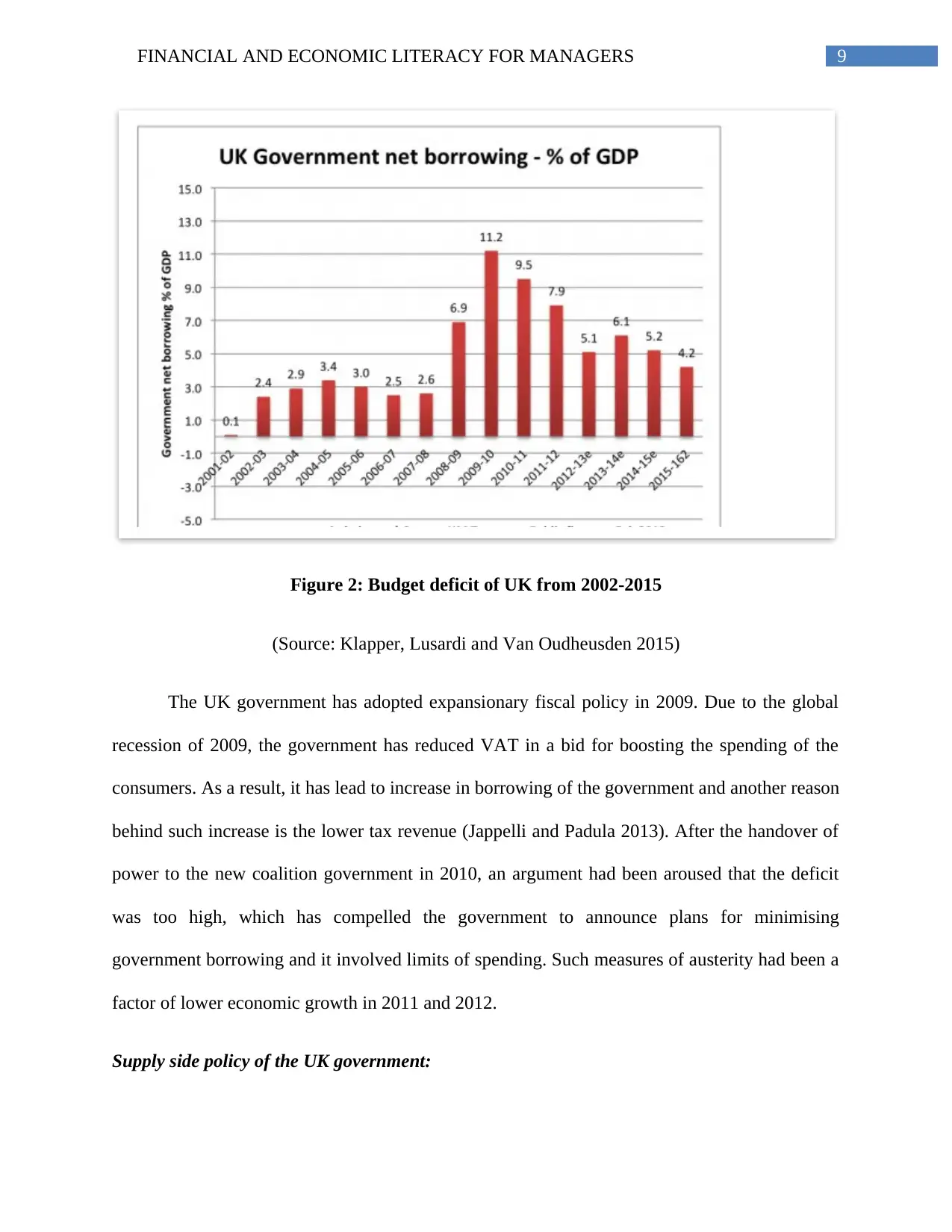
9FINANCIAL AND ECONOMIC LITERACY FOR MANAGERS
Figure 2: Budget deficit of UK from 2002-2015
(Source: Klapper, Lusardi and Van Oudheusden 2015)
The UK government has adopted expansionary fiscal policy in 2009. Due to the global
recession of 2009, the government has reduced VAT in a bid for boosting the spending of the
consumers. As a result, it has lead to increase in borrowing of the government and another reason
behind such increase is the lower tax revenue (Jappelli and Padula 2013). After the handover of
power to the new coalition government in 2010, an argument had been aroused that the deficit
was too high, which has compelled the government to announce plans for minimising
government borrowing and it involved limits of spending. Such measures of austerity had been a
factor of lower economic growth in 2011 and 2012.
Supply side policy of the UK government:
Figure 2: Budget deficit of UK from 2002-2015
(Source: Klapper, Lusardi and Van Oudheusden 2015)
The UK government has adopted expansionary fiscal policy in 2009. Due to the global
recession of 2009, the government has reduced VAT in a bid for boosting the spending of the
consumers. As a result, it has lead to increase in borrowing of the government and another reason
behind such increase is the lower tax revenue (Jappelli and Padula 2013). After the handover of
power to the new coalition government in 2010, an argument had been aroused that the deficit
was too high, which has compelled the government to announce plans for minimising
government borrowing and it involved limits of spending. Such measures of austerity had been a
factor of lower economic growth in 2011 and 2012.
Supply side policy of the UK government:
Paraphrase This Document
Need a fresh take? Get an instant paraphrase of this document with our AI Paraphraser
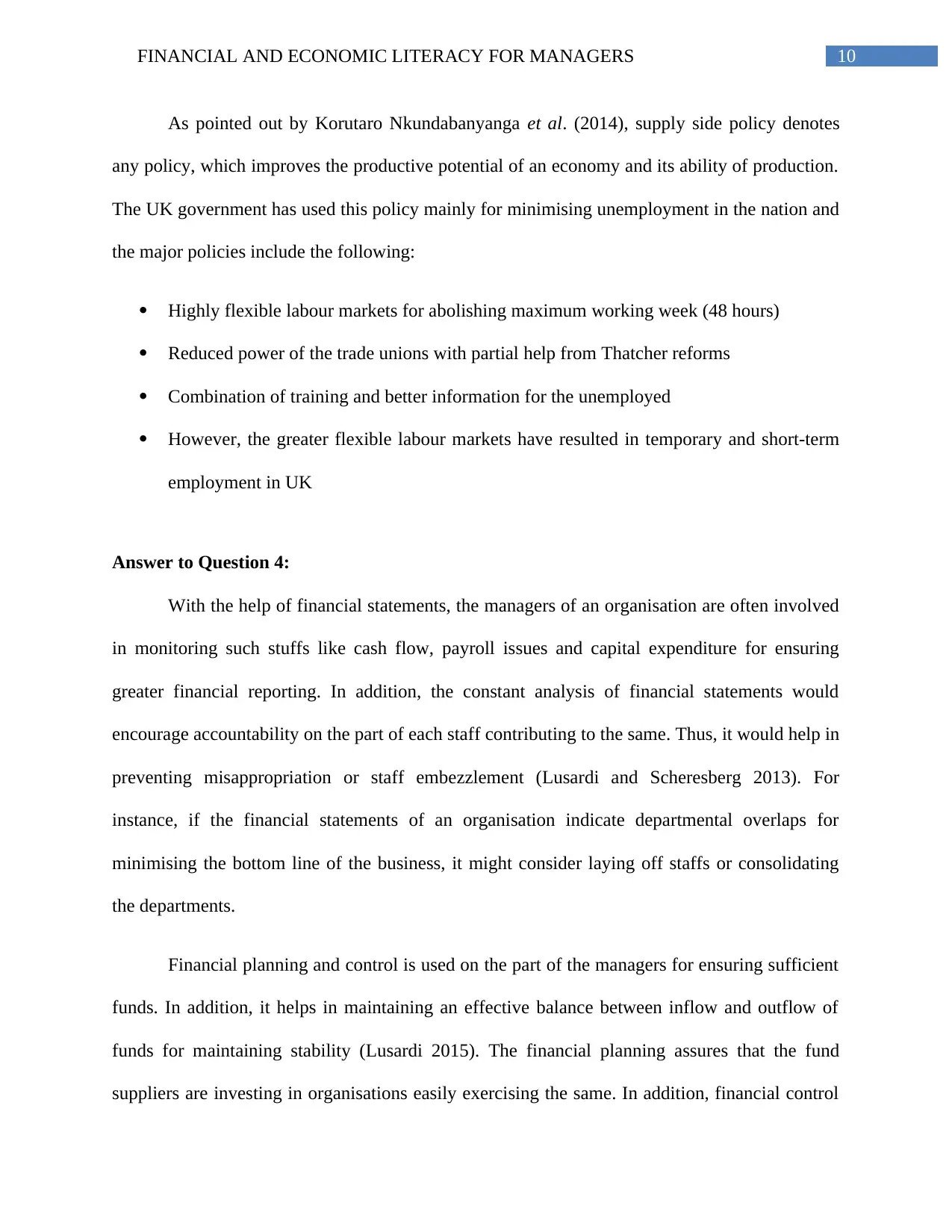
10FINANCIAL AND ECONOMIC LITERACY FOR MANAGERS
As pointed out by Korutaro Nkundabanyanga et al. (2014), supply side policy denotes
any policy, which improves the productive potential of an economy and its ability of production.
The UK government has used this policy mainly for minimising unemployment in the nation and
the major policies include the following:
Highly flexible labour markets for abolishing maximum working week (48 hours)
Reduced power of the trade unions with partial help from Thatcher reforms
Combination of training and better information for the unemployed
However, the greater flexible labour markets have resulted in temporary and short-term
employment in UK
Answer to Question 4:
With the help of financial statements, the managers of an organisation are often involved
in monitoring such stuffs like cash flow, payroll issues and capital expenditure for ensuring
greater financial reporting. In addition, the constant analysis of financial statements would
encourage accountability on the part of each staff contributing to the same. Thus, it would help in
preventing misappropriation or staff embezzlement (Lusardi and Scheresberg 2013). For
instance, if the financial statements of an organisation indicate departmental overlaps for
minimising the bottom line of the business, it might consider laying off staffs or consolidating
the departments.
Financial planning and control is used on the part of the managers for ensuring sufficient
funds. In addition, it helps in maintaining an effective balance between inflow and outflow of
funds for maintaining stability (Lusardi 2015). The financial planning assures that the fund
suppliers are investing in organisations easily exercising the same. In addition, financial control
As pointed out by Korutaro Nkundabanyanga et al. (2014), supply side policy denotes
any policy, which improves the productive potential of an economy and its ability of production.
The UK government has used this policy mainly for minimising unemployment in the nation and
the major policies include the following:
Highly flexible labour markets for abolishing maximum working week (48 hours)
Reduced power of the trade unions with partial help from Thatcher reforms
Combination of training and better information for the unemployed
However, the greater flexible labour markets have resulted in temporary and short-term
employment in UK
Answer to Question 4:
With the help of financial statements, the managers of an organisation are often involved
in monitoring such stuffs like cash flow, payroll issues and capital expenditure for ensuring
greater financial reporting. In addition, the constant analysis of financial statements would
encourage accountability on the part of each staff contributing to the same. Thus, it would help in
preventing misappropriation or staff embezzlement (Lusardi and Scheresberg 2013). For
instance, if the financial statements of an organisation indicate departmental overlaps for
minimising the bottom line of the business, it might consider laying off staffs or consolidating
the departments.
Financial planning and control is used on the part of the managers for ensuring sufficient
funds. In addition, it helps in maintaining an effective balance between inflow and outflow of
funds for maintaining stability (Lusardi 2015). The financial planning assures that the fund
suppliers are investing in organisations easily exercising the same. In addition, financial control
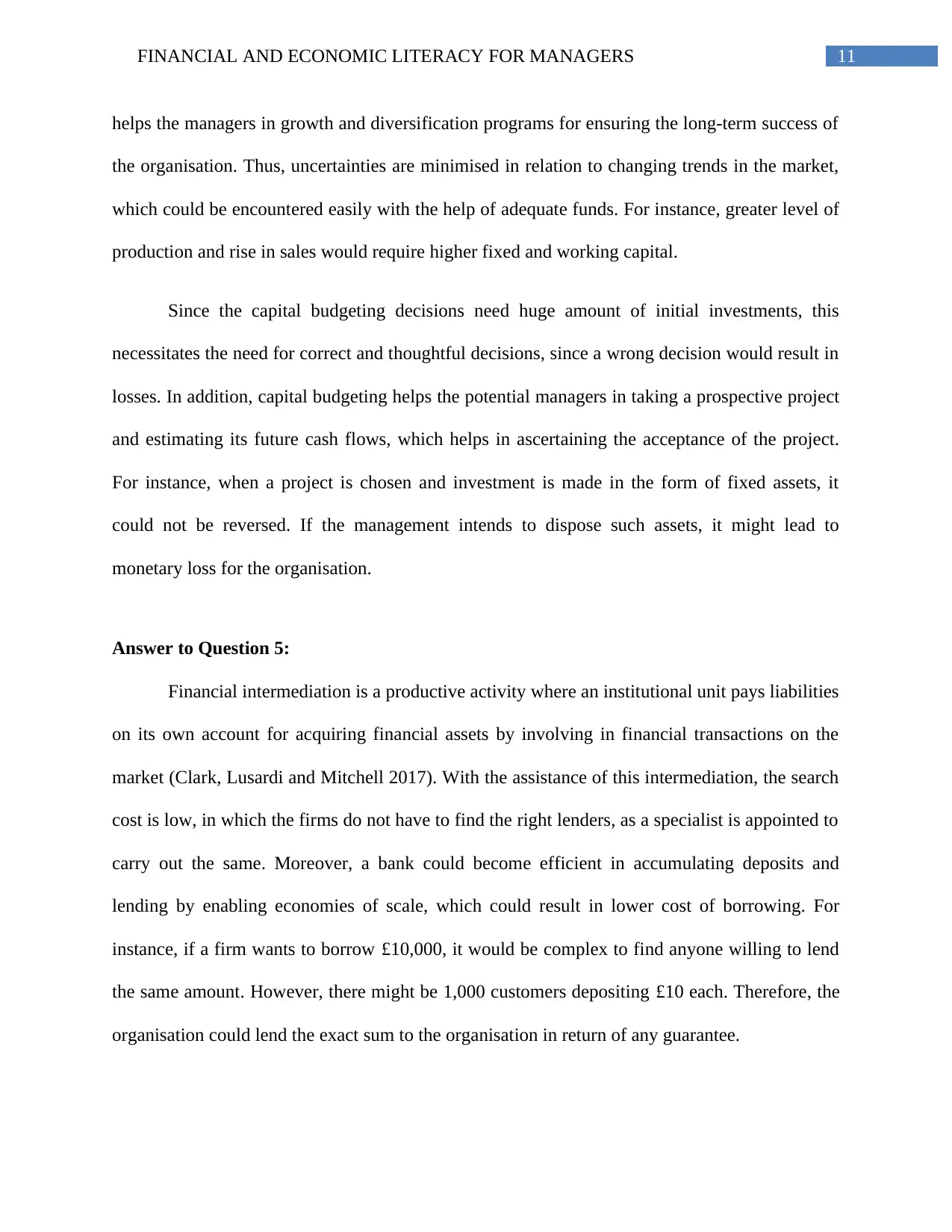
11FINANCIAL AND ECONOMIC LITERACY FOR MANAGERS
helps the managers in growth and diversification programs for ensuring the long-term success of
the organisation. Thus, uncertainties are minimised in relation to changing trends in the market,
which could be encountered easily with the help of adequate funds. For instance, greater level of
production and rise in sales would require higher fixed and working capital.
Since the capital budgeting decisions need huge amount of initial investments, this
necessitates the need for correct and thoughtful decisions, since a wrong decision would result in
losses. In addition, capital budgeting helps the potential managers in taking a prospective project
and estimating its future cash flows, which helps in ascertaining the acceptance of the project.
For instance, when a project is chosen and investment is made in the form of fixed assets, it
could not be reversed. If the management intends to dispose such assets, it might lead to
monetary loss for the organisation.
Answer to Question 5:
Financial intermediation is a productive activity where an institutional unit pays liabilities
on its own account for acquiring financial assets by involving in financial transactions on the
market (Clark, Lusardi and Mitchell 2017). With the assistance of this intermediation, the search
cost is low, in which the firms do not have to find the right lenders, as a specialist is appointed to
carry out the same. Moreover, a bank could become efficient in accumulating deposits and
lending by enabling economies of scale, which could result in lower cost of borrowing. For
instance, if a firm wants to borrow £10,000, it would be complex to find anyone willing to lend
the same amount. However, there might be 1,000 customers depositing £10 each. Therefore, the
organisation could lend the exact sum to the organisation in return of any guarantee.
helps the managers in growth and diversification programs for ensuring the long-term success of
the organisation. Thus, uncertainties are minimised in relation to changing trends in the market,
which could be encountered easily with the help of adequate funds. For instance, greater level of
production and rise in sales would require higher fixed and working capital.
Since the capital budgeting decisions need huge amount of initial investments, this
necessitates the need for correct and thoughtful decisions, since a wrong decision would result in
losses. In addition, capital budgeting helps the potential managers in taking a prospective project
and estimating its future cash flows, which helps in ascertaining the acceptance of the project.
For instance, when a project is chosen and investment is made in the form of fixed assets, it
could not be reversed. If the management intends to dispose such assets, it might lead to
monetary loss for the organisation.
Answer to Question 5:
Financial intermediation is a productive activity where an institutional unit pays liabilities
on its own account for acquiring financial assets by involving in financial transactions on the
market (Clark, Lusardi and Mitchell 2017). With the assistance of this intermediation, the search
cost is low, in which the firms do not have to find the right lenders, as a specialist is appointed to
carry out the same. Moreover, a bank could become efficient in accumulating deposits and
lending by enabling economies of scale, which could result in lower cost of borrowing. For
instance, if a firm wants to borrow £10,000, it would be complex to find anyone willing to lend
the same amount. However, there might be 1,000 customers depositing £10 each. Therefore, the
organisation could lend the exact sum to the organisation in return of any guarantee.
⊘ This is a preview!⊘
Do you want full access?
Subscribe today to unlock all pages.

Trusted by 1+ million students worldwide
1 out of 19
Related Documents
Your All-in-One AI-Powered Toolkit for Academic Success.
+13062052269
info@desklib.com
Available 24*7 on WhatsApp / Email
![[object Object]](/_next/static/media/star-bottom.7253800d.svg)
Unlock your academic potential
Copyright © 2020–2026 A2Z Services. All Rights Reserved. Developed and managed by ZUCOL.





